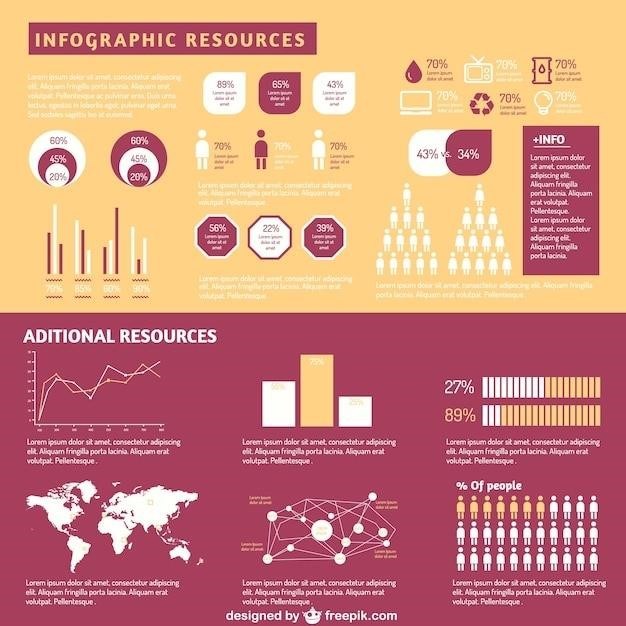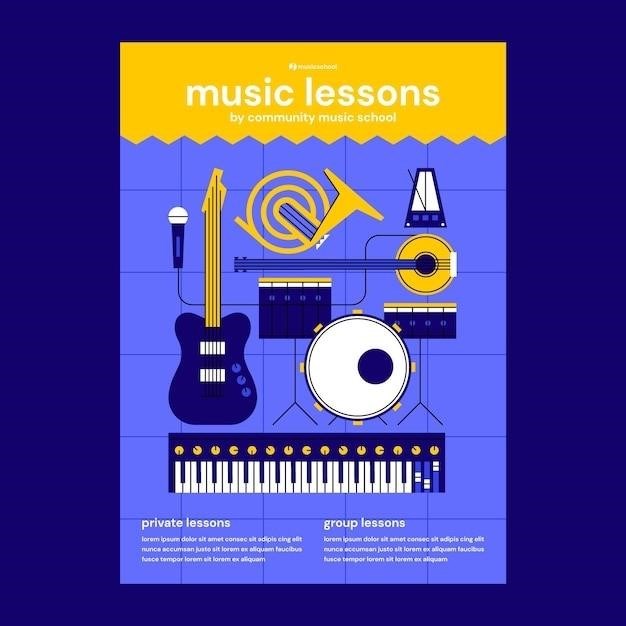Statistics for Dummies PDF⁚ A Guide to Understanding Data
Statistics For Dummies is a comprehensive guide to understanding data, covering topics like descriptive and inferential statistics, key statistical concepts, real-world applications, and resources for further learning. The book is written in a clear and concise style, making it accessible to readers of all levels; It is packed with practical advice and real-world problems, helping you to develop a solid understanding of statistics and its applications.
The Essence of Statistics
Statistics is a powerful tool for making sense of the world around us. It provides a framework for collecting, analyzing, and interpreting data, allowing us to draw meaningful conclusions and make informed decisions. At its core, statistics is about understanding variability and uncertainty. In a nutshell, statistics is the science of numbers. It helps us to make sense of data, to see patterns and trends, and to make predictions about the future. Statistics is used in a wide range of fields, including business, science, healthcare, and government. It is an essential tool for anyone who wants to understand the world around them.
Types of Statistics⁚ Descriptive and Inferential
Statistics can be broadly categorized into two main types⁚ descriptive statistics and inferential statistics. Descriptive statistics focuses on summarizing and presenting data in a meaningful way. It involves calculating measures like mean, median, mode, standard deviation, and variance to describe the central tendency and spread of data. Inferential statistics, on the other hand, goes beyond simply describing data. It uses sample data to draw conclusions and make inferences about a larger population. This involves techniques like hypothesis testing, confidence intervals, and regression analysis. Descriptive statistics is like a snapshot of the data, while inferential statistics is like a movie that tells a story about the data.
Understanding Data⁚ Collection, Analysis, and Interpretation
The process of understanding data involves three key stages⁚ collection, analysis, and interpretation. Data collection is the first step, where information is gathered from various sources, such as surveys, experiments, or existing databases. This data can be qualitative, like opinions and descriptions, or quantitative, like numbers and measurements. Data analysis then comes into play, where collected data is organized, cleaned, and processed to identify patterns and trends; This often involves using statistical techniques to summarize and visualize the data. Finally, the interpretation stage involves drawing meaningful conclusions from the analyzed data. This involves understanding the significance of findings, identifying potential biases, and drawing insights that can be used for decision-making.

Key Statistical Concepts
To navigate the world of statistics, it’s essential to grasp some fundamental concepts. These concepts provide a foundation for understanding and applying statistical methods. One important concept is the difference between descriptive and inferential statistics. Descriptive statistics focuses on summarizing and describing data using measures like mean, median, and mode. Inferential statistics, on the other hand, aims to draw conclusions about a population based on a sample of data. Understanding these concepts allows you to discern whether a statistical analysis is merely describing a dataset or making inferences about a larger group. Probability is another crucial concept, as it helps quantify the likelihood of events occurring. Knowing these concepts helps you understand how statistics are used to analyze and interpret data, enabling you to make informed decisions based on data-driven insights.
4.1 Mean, Median, and Mode
Understanding the mean, median, and mode is crucial for interpreting and summarizing data. The mean, often referred to as the average, is calculated by summing all the values in a dataset and dividing by the total number of values. The median represents the middle value in a dataset when arranged in ascending order. If the dataset has an even number of values, the median is the average of the two middle values. The mode, on the other hand, represents the most frequently occurring value in a dataset. These measures provide insights into the central tendency of data, helping us understand where the data is clustered. For instance, the mean salary of employees in a company can indicate the average earnings, while the median salary provides a more accurate representation of the typical salary, as it’s less affected by extreme values.
4.2 Standard Deviation and Variance
Standard deviation and variance are measures of dispersion that quantify the spread or variability of data points around the mean. Standard deviation, often represented by the symbol ‘σ’, measures how much, on average, individual data points deviate from the mean. A larger standard deviation indicates greater variability, meaning the data points are more spread out. Variance, represented by ‘σ²’, is the square of the standard deviation. It provides a measure of how much the data points differ from the mean, but in squared units. Both standard deviation and variance are crucial for understanding the distribution of data and making informed statistical inferences. For example, in a study of student test scores, a high standard deviation might indicate a wider range of performance, while a low standard deviation suggests that most students scored close to the average.
4.3 Probability and Its Applications
Probability is a fundamental concept in statistics that quantifies the likelihood of an event occurring. It is expressed as a number between 0 and 1, where 0 represents an impossible event and 1 represents a certain event. Probability theory helps us understand and predict random phenomena in various fields. For instance, in gambling, probability is used to calculate the odds of winning or losing. In healthcare, probability is employed to assess the effectiveness of treatments and the risk of developing certain diseases. Probability also plays a vital role in quality control, where it is used to determine the likelihood of defective products. Understanding probability enables us to make informed decisions based on the likelihood of different outcomes.
4.4 Confidence Intervals and Hypothesis Testing
Confidence intervals provide a range of values within which a population parameter is likely to lie, based on a sample. They are often expressed as a percentage, such as a 95% confidence interval. This means that if we were to repeat the sampling process many times, we would expect the true population parameter to fall within the calculated confidence interval 95% of the time. Hypothesis testing is a statistical procedure used to determine whether there is enough evidence to reject a null hypothesis. The null hypothesis is a statement about the population parameter that we are trying to disprove. Hypothesis testing involves collecting data, calculating a test statistic, and determining the p-value. The p-value represents the probability of observing the data if the null hypothesis is true. If the p-value is less than the significance level (typically 0.05), we reject the null hypothesis and conclude that there is evidence to support the alternative hypothesis.
Real-World Applications of Statistics
Statistics permeates our daily lives, influencing decisions in various fields. Businesses leverage statistical analysis to understand customer behavior, optimize marketing campaigns, and forecast sales. Healthcare professionals rely on statistics to track disease trends, evaluate treatment effectiveness, and ensure patient safety. In the realm of finance, statistics are crucial for risk assessment, portfolio management, and investment analysis. Governments utilize statistics for policy formulation, resource allocation, and social planning. The power of statistics extends to scientific research, where it enables researchers to analyze data, draw conclusions, and advance knowledge across diverse disciplines. From analyzing public opinion polls to conducting clinical trials, statistics play a pivotal role in shaping our understanding of the world.
Resources for Learning Statistics
Embarking on a journey to learn statistics doesn’t have to be daunting. Numerous resources cater to all learning styles and preferences. Online courses and tutorials, readily available on platforms like Coursera, edX, and Khan Academy, offer structured lessons, interactive exercises, and expert guidance. For those who prefer a more traditional approach, a plethora of books and articles delve into the intricacies of statistics. From introductory guides like “Statistics For Dummies” to more advanced texts covering specific statistical techniques, there’s a resource for every level of understanding. Finally, statistical software packages, such as SPSS, R, and SAS, provide powerful tools for data analysis and visualization, allowing you to apply your newfound knowledge to real-world datasets.
6.1 Online Courses and Tutorials
The digital age has revolutionized learning, and statistics is no exception. Numerous online platforms offer a wealth of courses and tutorials, making it easier than ever to grasp the fundamentals of this essential discipline. Coursera, edX, and Khan Academy are just a few examples of platforms that provide structured lessons, interactive exercises, and expert guidance. These resources cater to various learning styles, whether you prefer watching video lectures, engaging in interactive quizzes, or working through practical assignments. From introductory courses covering basic statistical concepts to more advanced modules exploring specific statistical techniques, online learning resources offer a flexible and accessible way to delve into the world of statistics.
6.2 Books and Articles
While online resources offer a dynamic and interactive approach to learning statistics, traditional books and articles continue to be valuable companions on this journey. Libraries and bookstores house a wide selection of texts tailored to different levels of understanding, from introductory guides like “Statistics For Dummies” to more advanced treatises on specific statistical techniques. These resources provide a structured and in-depth exploration of statistical concepts, often accompanied by illustrative examples and real-world applications. Additionally, numerous articles published in academic journals and popular science magazines offer insights into the latest advancements and applications of statistics across various fields. Whether you prefer the structured approach of a textbook or the engaging narratives of articles, these resources offer a valuable complement to online learning.
6.3 Statistical Software
In the modern age of data analysis, statistical software plays a crucial role in simplifying complex calculations and providing powerful tools for data visualization and interpretation. Numerous software packages cater to both beginners and seasoned statisticians, ranging from user-friendly interfaces like SPSS and Minitab to more advanced programming-based options like R and Python. These software packages offer a wide array of features, including data management, descriptive statistics, hypothesis testing, regression analysis, and data visualization. They provide a powerful platform for exploring data, uncovering patterns, and drawing meaningful conclusions. The choice of software often depends on individual needs, experience level, and specific research goals. Whether you opt for a user-friendly point-and-click interface or a more flexible programming environment, embracing statistical software can significantly enhance your data analysis capabilities.
Common Misconceptions About Statistics
Statistics, while a powerful tool for understanding data, is often misunderstood. One common misconception is that statistics can be manipulated to prove any point, leading to the belief that statistical results are inherently unreliable. However, while data can be misused or misinterpreted, sound statistical analysis adheres to rigorous methodologies and aims for objectivity. Another misconception is that statistics are only relevant to scientists and researchers. In reality, statistics are embedded in our everyday lives, from interpreting weather forecasts to understanding financial reports. Statistics are not simply about numbers; they are about making sense of the world around us. By dispelling these common misconceptions, we can better appreciate the power and importance of statistics in navigating a data-driven world.
Statistics in Everyday Life
Statistics are not confined to textbooks and research papers; they are woven into the fabric of our daily lives. From the moment we wake up, we encounter statistics. The weather forecast we check is based on statistical analysis of historical data. The news we consume often presents statistics about economic indicators, crime rates, or public health trends. When we shop online, algorithms based on statistical models recommend products tailored to our preferences. Even the games we play online utilize statistics to track our progress and create personalized challenges. Statistics are the invisible language that helps us understand the world around us, making informed decisions and navigating a world increasingly driven by data.
The Importance of Statistical Literacy
In a world awash with data, statistical literacy is no longer a luxury but a necessity. It empowers us to critically evaluate information, make informed decisions, and avoid being misled by statistics used for manipulation or persuasion. A basic understanding of statistics allows us to discern between meaningful trends and random fluctuations, to recognize biases in data collection and interpretation, and to critically assess the validity of claims based on statistical evidence. Statistical literacy is essential for navigating the complexities of the modern world, whether it’s understanding health statistics, interpreting financial data, or evaluating political polls. In an age of information overload, being statistically literate is key to becoming a discerning and informed citizen.
Conclusion⁚ Statistics for Dummies ― Your Path to Data Understanding
Statistics for Dummies provides a user-friendly introduction to the world of data analysis, demystifying complex concepts and making them accessible to everyone. By mastering the fundamentals of statistics, you gain the ability to interpret data, make informed decisions, and navigate the ever-increasing information landscape. Whether you’re a student, a professional, or simply someone seeking a better understanding of the world around you, Statistics for Dummies is your guide to unlocking the power of data and making sense of the numbers that shape our lives. This book is not just about formulas and calculations; it’s about empowering you to become a more informed and confident data consumer.


